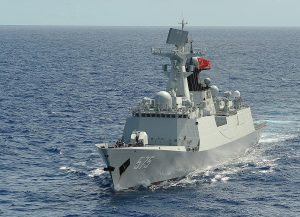Americans are keen to effectively “manage” their relations with China. They view the stakes as enormously high – defense of the “rules-based order,” with the credibility of the U.S. alliance system perceived to be at stake. U.S. leaders have advocated for direct military talks and the start of serious arms control negotiations with Beijing.
Chinese leaders see things quite differently. They seek a definitive resolution to the hard issues in the bilateral relationship – not least the question of Taiwan’s status. For them, “crisis management” amounts to “giving seatbelts to speeders” – allowing the United States to rebuff China’s entreaties to take its demands for sovereignty and respect seriously.
Aside from the exceedingly volatile issue of Taiwan, the next most dangerous issue in China-U.S. relations involves the maritime realm. A steady stream of reports has implicated the Chinese Coast Guard (CCG), along with the Chinese Maritime Militia, in bullying various neighbors within fishing disputes and concerning the right to explore for seabed resources. This combustible brew has led to crises in the very recent past, including a string of dangerous standoffs between the Philippines, a U.S. treaty ally, and China in and around Second Thomas Shoal in the South China Sea. These run-ins could have resulted in hostilities and even armed confrontation between the two nuclear-armed superpowers.
No doubt, Chinese non-military assets have engaged in aggressive behavior with maritime neighbors. Moreover, the Hague-based Permanent Court of Arbitration indicated in a 2016 ruling that many of China’s claims in the South China Sea are excessive. Still, the Western media has also engaged in threat inflation in this domain, regrettably. For example, a leading U.S. newspaper recently printed a correction after erroneously claiming in a front-page story that Chinese cutters were now mostly armed with anti-ship cruise missiles.
The best approach to mitigate such “white hull” tensions will be to create additional linkages, for example by establishing a robust South Pacific Coast Guard Forum. In fact, the U.S. Coast Guard and the CCG previously did have smooth cooperation, but these contacts atrophied and broke down in recent years. The sad result of discarding engagement has been spiking regional tensions.
More challenging still is the fraught military-to-military relationship. True, annual Military Maritime Consultative Agreement (MMCA) talks, along with the Code for Unplanned Encounters at Sea (CUES) are helpful. Yet such formulas are clearly insufficient to keep the peace over the long run. More fundamental change is required on both sides. Beijing must continue to enhance its military transparency, adjust its troubling tendency toward unsafe intercepts at sea and in the air, and also to reassure its neighbors regarding its intentions. Meanwhile, Washington should reevaluate its system of unrelenting surveillance along China’s coasts. That system is expensive, dangerous, provocative, and quite unnecessary from a military-technical point of view.
To earnestly pursue peace across the Pacific in the 21st century will require “deep engagement” between the naval and maritime services of the United States and China. Meanwhile, they also need to hold joint discussions to ascertain the parameters of rivalry in cutting edge artificial intelligence systems, such as in the domain of unmanned underwater vehicles (UUVs). Both superpowers are on the cusp of deploying robotic submarines, and this novel arena of rivalry could easily spin out of control.
In a series of articles, Chinese and American experts intend to make explicit the misperceptions that drive the mistrust in the ever-increasing instability in the bilateral relationship. Find the whole series here.

































